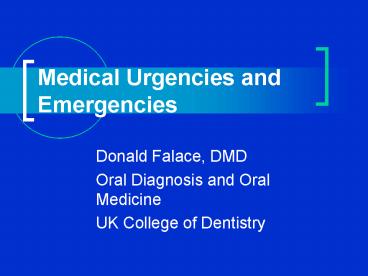Medical Urgencies and Emergencies - PowerPoint PPT Presentation
1 / 13
Title:
Medical Urgencies and Emergencies
Description:
Enable you to respond to an urgent medical need in a ... Syncope. Hypoglycemia. Seizure. Asthmatic attack. Hyperventilation. Angina. Mild allergic reaction ... – PowerPoint PPT presentation
Number of Views:634
Avg rating:3.0/5.0
Title: Medical Urgencies and Emergencies
1
Medical Urgencies and Emergencies
- Donald Falace, DMD
- Oral Diagnosis and Oral Medicine
- UK College of Dentistry
2
Goals
- Develop a sense of vigilance and anticipation
- Enable you to respond to an urgent medical need
in a reasonably confident and efficient fashion
3
Urgencies vs. Emergencies
- Urgency a problem that requires prompt response
it is not immediately life threatening but could
become so if not resolved promptly - Syncope
- Hypoglycemia
- Seizure
- Asthmatic attack
- Hyperventilation
- Angina
- Mild allergic reaction
- Stroke
- Emergency a problem that is immediately life
threatening and requires immediate action - Cardiac arrest
- Anaphylaxis
- Obstructed airway
4
Be observant!
- Look at and listen to your patient
- Watch for changes in
- Speech (slurring, halting, excessively talkative,
silent) - Behavior (becomes quiet, restless, agitated,
anxious, fearful, uncomfortable, nauseated, has
difficulty breathing, non-communicative) - Appearance (pale, ashen, flushed, sweating,
trembling)
5
Anticipation, Prevention and Planning
- Anticipation What type of urgency/emergency can
you anticipate with this patient? - Prevention What can you do to decrease the risk
of occurrence? - Planning What would you do if the problem does
occur?
6
Reality Check
- It is estimated that about 90 of urgencies -
emergencies can be prevented. - This means that 10 will occur in spite of our
best efforts
7
UKCD Urgency/Emergency Response Protocol in Clinic
- Attend to the patient
- If conscious, allow patient to assume a
comfortable position, monitor vital signs, give
oxygen as needed, try to determine what the
problem is - If unconscious, PABCD
- Stay with the patient
- Call for help from your supervising faculty
member (or any faculty member) - If not immediately life-threatening and
additional help is needed, call Oral Surgery
3-5279 - If cardiac arrest or anaphylaxis, call 3-5200 and
report code 500 and give location and nature
of the problem
8
Location of Emergency Equipment
9
Medical Emergencies Equipment in the Clinic
- Oxygen tank, ambu bag, tubing and mask
- Automated blood pressure cuff and pulse oximeter
- Drug box
- Defibrillator
10
Drug Box
- Albuterol inhaler
- Ammonia ampules
- Aspirin
- Diphenhydramine (oral injectable)
- Epinephrine (EpiPen ampules)
- Glucose
- Nitroglycerine (spray tablets)
- Ephedrine (hypotension)
- Solucortef (adrenal crisis)
- Narcan (narcotic overdose)
- Atropine (bradycardia)
11
Defibrillator
Located in COD on 2nd, 3rd and 5th floors
12
Phone
- Oral Surgery
- 3-5749
- Cardiac Arrest or Anaphylaxis
- 3-5200 and report code 500
- Outside of Medical Center - 911
13
Emergency Medicine in DentistryStanley Malamed,
DDS
- Disk 1
- Preparation for emergencies
- Emergency drug kit
- Basic management protocol
- Disk 2
- Altered consciousness
- Respiratory distress
- Allergic response
- Cardiovascular problems































